Revisiting
June 8, 2008
I have now a three-year history with Sourdough Trail. I know it far better than the back of my hand, which I couldn’t begin to describe with its veins, scars, spots, etc. Not that I’ve made any attempt to learn the place by heart. In my wanderings, I’ve simply come to know quite a few of the trees and other things. I’m content to let the serendipity of experience and the filter of the unconscious determine what I can remember.
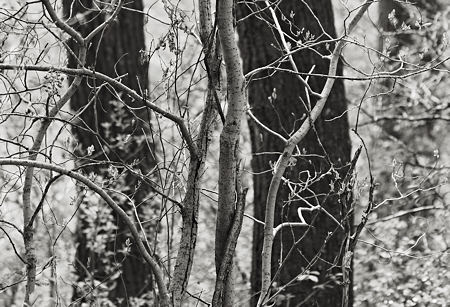
I made a photograph earlier this week of a scene I usually notice as I walk past. I first saw to photograph it half a year into the project, when I was taken by a last pair of leaves hanging there, arrested in their fall by a twig that carried them well into winter.
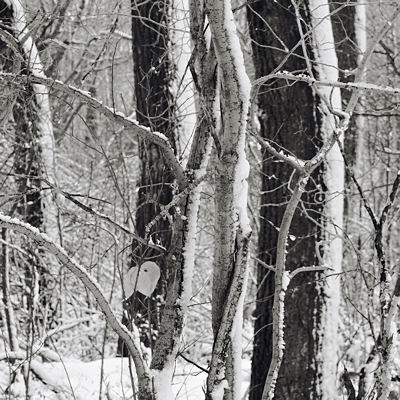
Two months later I found myself captivated by some squiggling branches against dark, majestic trunks, but I didn’t realize until later that this was the same spot, and my enduring pair had finally been blown from their perch.
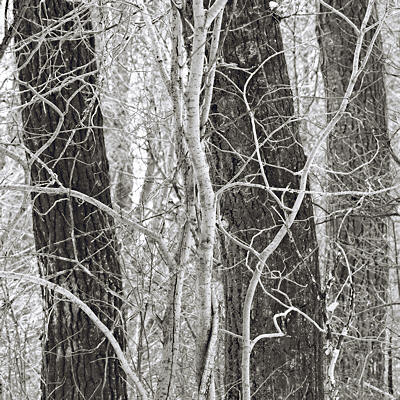
Below is a different pair I first saw one late fall, their smooth bark and muscular attitude standing in strong contrast to the surrounding wrack. Afterwards, I lost track of where they were and didn’t manage to find them for a long time. Even now I sometimes miss them if I forget to watch closely at the right point. Despite their appeal, I continued to pass them by photographically, until a day or two ago.
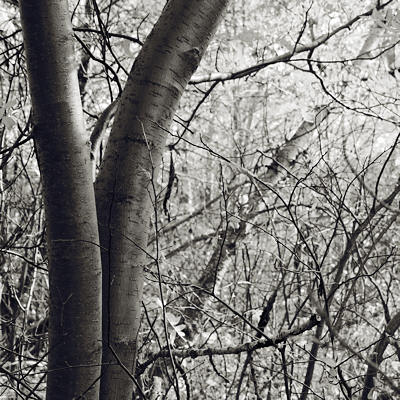
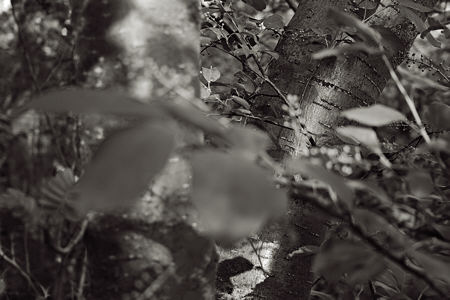
As you can see, they are doing quite well, and will likely be photo fodder for years to come.
These and other repeat subjects might serve as touchstones in assessing changes in both the place and my photography. One of my goals for this coming year is to consider that evolution.
Long time ago, in my going-to-the-ashram days, I took a week-long class in Sanskrit. We learned to chant the alphabet, which is a lovely thing, and got an overview of the grammar. Sanskrit conjugates singlular, plural, and dual. I’ve learned since that there are a few other languages that also recognize the significance of “we two” in addition to “I” and “we many” but I don’t remember what they are. I remain charmed by the idea (if daunted by the grammar). This post reminded me of that.
That’s a fascinating bit of linguistics I don’t think I ever heard before. Wikipedia says the dual (two in number) used to be part of Old English, though it now exists in only a few remnants like both/all, between/among, latter/last, either/any, and neither/none. Among modern languages it appears to be most prominent in Arabic.
Two of something is sometimes said to be bad in a photograph, as the viewer supposedly “wants” a single clear subject. But I think two can set up a very powerful relationship, which itself becomes the subject. I’m thinking of some of Aaron Siskind’s “conversations” abstracts; unfortunately, I can’t find a good example on the web at the moment.
Now you’ve got me wondering if I’m especially partial to pairs. That was also an important aspect of the saplings in a prior post.
There are a number of viewer/viewed systems that insist there must be an odd number of whatevers in view. I think these mandates — it works because of the singularity of the central image, because of the dynamism of the pair, because of the stability of the triangle — are a little silly. phooey. If “it works” it’s because it works. And if “phooey” is the extent of my intellectual reach tonight, I think it’s time to attempt sleeping.
be well, ether buddy.